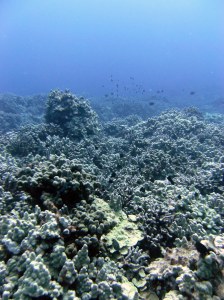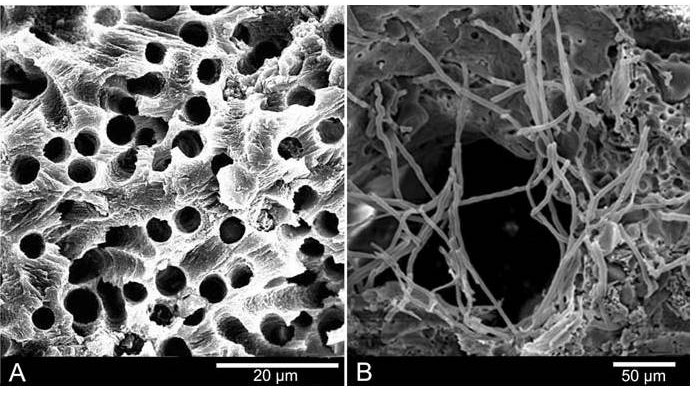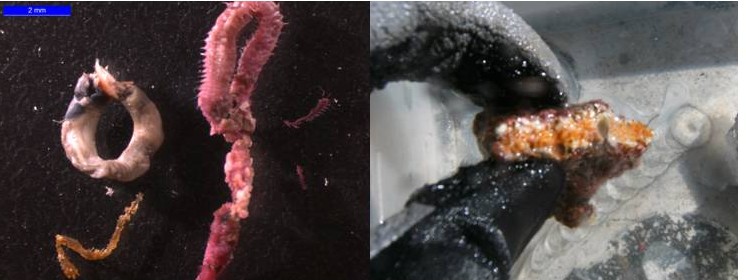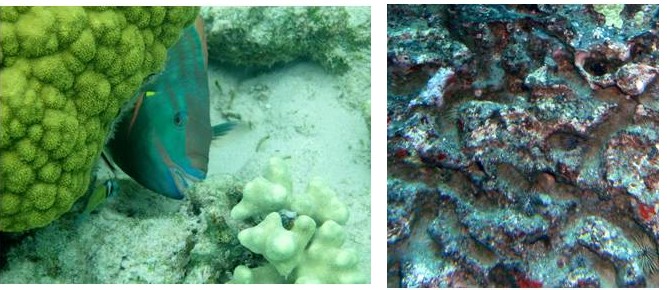Bioerosion is the removal of calcium carbonate substrate by biological agents1. Corals accrete calcium carbonate, or limestone, to form their skeleton. The coral skeletal framework forms the structure that provides food and shelter to the majority of coral reefs organisms. While corals are regularly accreting calcium carbonate, bioeroders are naturally breaking it down to make rubble and sand. The balance between accretion and erosion is delicate. If bioerosion is excessive then coral destruction will be faster than coral growth and corals will not be able to keep up with sea-level rise. This makes it very important to understand the rates at which coral reefs are being eroded and what environmental and/or human-induced factors might be affecting bioerosion rates.
Who are the bioeroders?
The bioeroder community is made of many different types of animals, plants, and even bacteria. They erode coral skeleton, mostly dead coral, mechanically by removing calcium carbonate with teeth-like structures or chemically by excreting acidic compounds and dissolving the coral skeleton. There are 3 main functional groups of bioeroders: microborers, macroborers, and grazers.
Microborers:
Pictures courtesy of Tribollet (2008)2.These photographs were taken using a scanning electron microscope. The picture to the left are holes in a piece of coral caused by microborers and the picture on the right is the green algae that did the boring.
Microborers are tiny endolithic algae, cyanobacteria, and fungi. They bore microscopic holes into the surface of the substrate. You might think that something this tiny could not possibly have an big effect on a huge reef that is miles long and wide. If you think that, you are wrong. In Australia, microborers erode about 0.35 kg of calcium carbonate per meter square in a year3. If this rate is accurate for the entire Great Barrier Reef, then microborers alone could produce enough sand to fill 1.1 MILLION school buses in a single year!
Macroborers:
These are my favorite! 🙂 Macroborers are animals that erode the internal structure of coral skeleton. They increase the porosity of the coral framework making it weak and really easy to break. This community is made up of small marine worms (hundreds of different species), sponges, bivalves, and barnacles. I am very interested in understanding how the macroborer community make-up changes over space and time in Hawai`i.
Grazers are animals that scrape the surface of the coral skeletal framework. Grazers are mainly urchins and fish. These animals consume algae that is growing on the surface of the skeleton (some fish even eat live coral too) and end up scraping into the calcium carbonate while they try to eat. These scrapings change the surface area of the framework which has implications for physical processes, such as water exchange, on the reef.
Why care about bioerosion?
The coral reef framework provides many goods and services to not only the organisms on the reef, but to humans as well. Bioerosion weakens the coral skeletal framework reducing the mechanical stability of the reef. Coral reefs have the ability to absorb up to 90% of energy from wind-driven waves4 , protecting the shoreline and coastal property. If the skeleton is weakened then storm events and tsunamis will be much more destructive. Erosion can also alter the structural complexity of coral reefs and this complexity provides shelter for fish, crabs, and other invertebrates. If there is less shelter available for these animals then there will be less fish, crabs, and shrimp for us to eat. Finally, if bioerosion is excessive and erodes at a faster rate than corals accrete, coral reefs will not be able to keep up with sea-level rise.
So, is bioerosion bad? No. Bieorosion is a natural process and breaking down old dead coral makes room for new corals to grow. However, if the process of bioerosion is altered by natural or human activities, the delicate accretion-erosion balance will be thrown off and it could become destructive to coral reefs. Bioeroding communities have a major control on coral reef resilience and the services that we receive from coral reefs depends on how bioerosion responds to anthropogenic activities and climate change.
What am I doing to study bioerosion?
I am conducting three different studies to look at bioerosion in the Hawaiian Islands.
1) I am looking at very small scale variability in bioerosion to decipher what environmental parameters have the greatest effect on the bioeroder community and bioerosion rates. Within a single patch reef, I am currently collecting environmental data (pH, temperature, oxygen, chlorophyll, water turbulence, etc.) at a very high resolution and correlating these parameters with bioerosion rates and the bioeroder community. This experiment is currently ongoing in Kāne`ohe Bay on `Oahu.
2) While the fine-scale data will inform us on what parameters might control bioerosion, I am also interested in the general broad-scale variability in bioeroder communities and rates in the Hawaiian Archipelago. I am going to be collecting bioerosion data on 25 different reefs throughout the entire Hawaiian Archipelago (including the Papahānaumokuākea Marine National Monument in the Northwestern Hawaiian Islands). This will lead to some interesting conclusions because the monument is remote and protected; therefore, there is virtually no human interactions with the coral reefs. The Main Hawaiian Islands (these are the populated islands that everyone is familiar with) have a lot of anthropogenic influence.
3) To really understand how climate change and ocean acidification will influence bioerosion, I will conduct a lab experiment. I will place bioeroder communities into a seawater system with properties that are representative of future oceanic conditions under climate change. See my page on ocean acidification to learn more about what it is and what it has to do with climate change.
References:
1) Neumann, A. C. 1966. Observations on coastal erosion in Bermuda and measurements of boring rate of sponge Cliona lampa. Limnology and Oceanography 11:92-108.
2) Tribollet, A. 2008. The boring microflora in modern coral reef ecosystems: a review of its roles. Current Developments in Bioerosion:67-94.
3) Tudhope AW, Risk MJ. 1985. Rate of dissolution of carbonate sediments by microboring organisms, Davies Reef, Australia. J Sediment Petrol 55:440-447.
4) UNEP-WCMC. 2006. In the front line: Shoreline protection and other ecosystem services from mangroves and coral reefs. Cambridge, UK.






Pingback: Cool technology for bioerosion! | It's Not Boring…
Pingback: Wooster Geologists » Blog Archive » Wooster’s Fossils of the Week: Bioclaustration-boring structures in bryozoans from the Upper Ordovician of the Cincinnati region